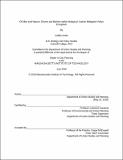| dc.contributor.advisor | Lawrence Susskind. | en_US |
| dc.contributor.author | Smith, Griffin (Griffin Wilcox) | en_US |
| dc.contributor.other | Massachusetts Institute of Technology. Department of Urban Studies and Planning. | en_US |
| dc.coverage.spatial | a-my--- | en_US |
| dc.date.accessioned | 2018-09-28T20:25:10Z | |
| dc.date.available | 2018-09-28T20:25:10Z | |
| dc.date.copyright | 2018 | en_US |
| dc.date.issued | 2018 | en_US |
| dc.identifier.uri | http://hdl.handle.net/1721.1/118201 | |
| dc.description | Thesis: M.C.P., Massachusetts Institute of Technology, Department of Urban Studies and Planning, 2018. | en_US |
| dc.description | This electronic version was submitted by the student author. The certified thesis is available in the Institute Archives and Special Collections. | en_US |
| dc.description | Cataloged from student-submitted PDF version of thesis. | en_US |
| dc.description | Includes bibliographical references (pages 130-143). | en_US |
| dc.description.abstract | Since 2000, Malaysia's GDP has risen by 264.4% and its population by 30.4%. The government has strongly pushed economic growth and development and aims to reach high-income status by 2020. At the same time, Malaysia has publicly committed to reduce its carbon intensity on a GDP basis by up to 45%. The outcome of this tension between Malaysia's development ambitions and its climate change goals may foreshadow the carbon trajectory for much of the rest of the developing world that will similarly seek to obtain high-income status in the coming decades. Through a series of in-country interviews in January 2018, I explored the workings of Malaysia's carbon mitigation policy ecosystem to understand what Malaysia has already done to implement its decarbonization objectives and what remains to be accomplished. I find that in three of Malaysia's core carbon mitigation policy sectors -- transportation and urban planning, renewable energy, and forestry -- the government and other actors have implemented a range of mitigation approaches. While the government, NGOs, corporations, and the public have achieved some initial successes, many barriers still inhibit mitigation efforts. I also identify cross-cutting themes from the interviews that operate within the policy sectors and the carbon mitigation policy ecosystem as a whole. These themes both enable and inhibit carbon mitigation. These include: a diversity of actors; state transfer pathways; internalization of exogenous drivers; a focus on sustainability planning and action; federal-state friction; absence of climate control hub; limited government enforcement, capacity, and regulation; and sustainability and development aspirations and constraints. I further find that both the policy sectors and these themes fit within the theories of decarbonization pathways and carbon lock-in. I conclude by offering six core recommendations to the new Malaysian government that won office on May 9, 2018 that focus on driving both carbon mitigation and economic growth: improve public transportation connectivity, maximize the efficacy of existing renewable energy policies, shift the energy system, align federal and state incentives around forest protection, improve the government's internal program management, and start adaptation efforts now. | en_US |
| dc.description.statementofresponsibility | by Griffin Smith. | en_US |
| dc.format.extent | 143 pages | en_US |
| dc.language.iso | eng | en_US |
| dc.publisher | Massachusetts Institute of Technology | en_US |
| dc.rights | MIT theses are protected by copyright. They may be viewed, downloaded, or printed from this source but further reproduction or distribution in any format is prohibited without written permission. | en_US |
| dc.rights.uri | http://dspace.mit.edu/handle/1721.1/7582 | en_US |
| dc.subject | Urban Studies and Planning. | en_US |
| dc.title | Of man and nature : drivers and barriers within Malaysia's carbon mitigation policy ecosystem | en_US |
| dc.type | Thesis | en_US |
| dc.description.degree | M.C.P. | en_US |
| dc.contributor.department | Massachusetts Institute of Technology. Department of Urban Studies and Planning | |
| dc.identifier.oclc | 1054184608 | en_US |
